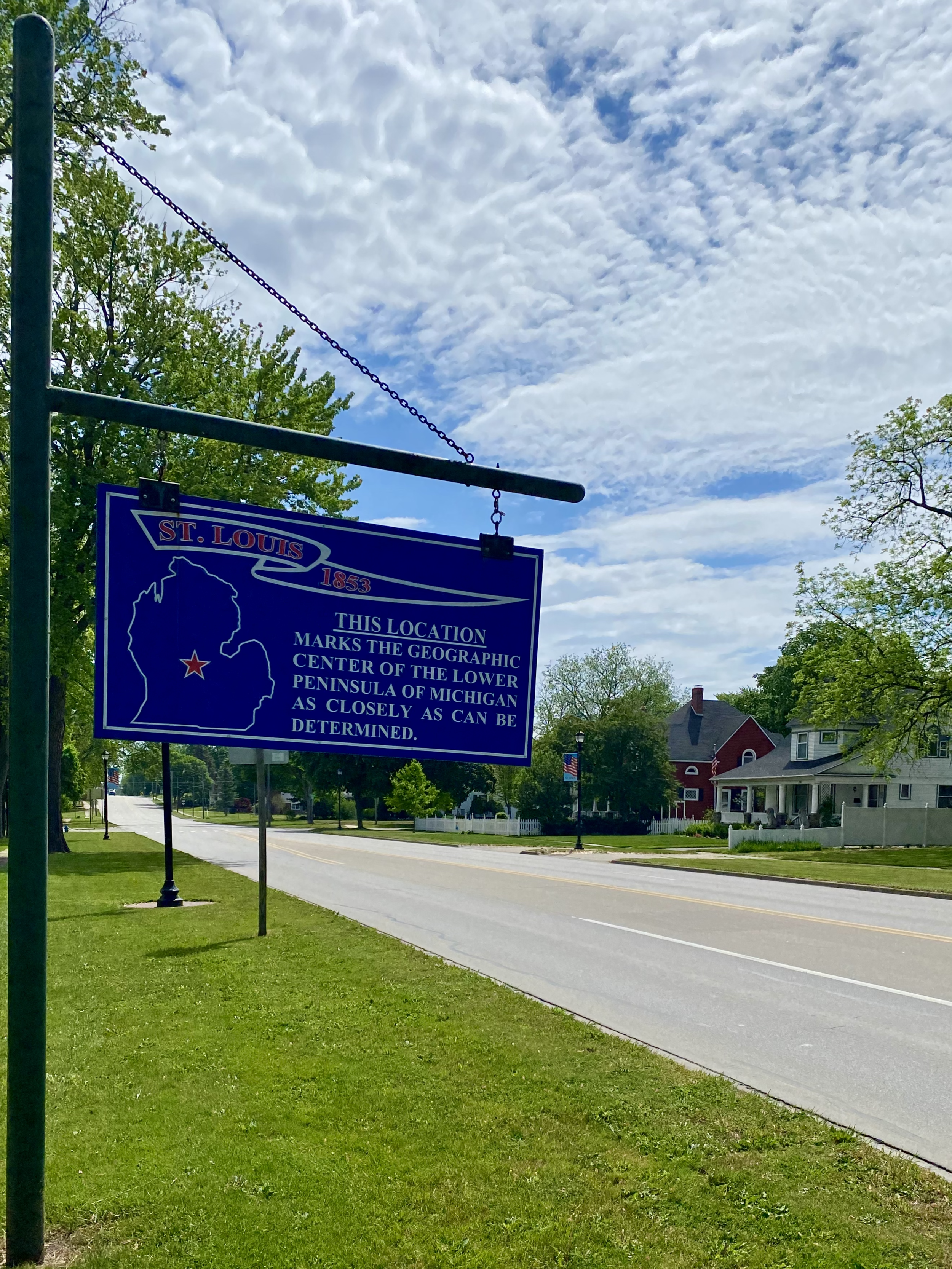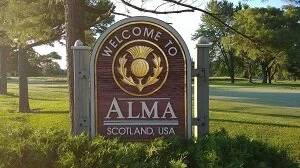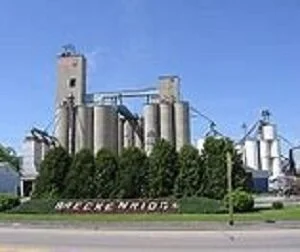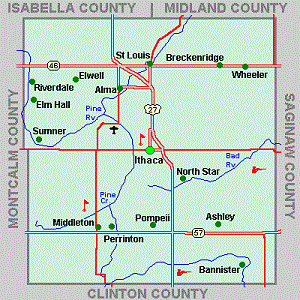
Where we work.
“The history of life on earth has been a history ofinteaction between living things and their environment.” Rachel Caron, Silent Spring, the book Velsicol Chemical tried to prevent from being published in 1962.
Our Location
We are located in the center of the Lower Peninsula of Michigan, primarily in Gratiot County. As shown on the map, the watershed for the Pine River begins west of Alma and St. Louis, Michigan, and then flows in an arc merging at Midland, Michigan (in neighboring Midland County, with two other rivers, the Chippewa and Tittabawassee), eventually flowing as the Saginaw River into Saginaw Bay, part of Lake Huron in the Great Lakes Basin of Canada and the United States.
Gratiot County, Michigan
The region is underlain by brine deposits that have supplied key ingredients for chemical manufacturers. There is a small oil field in the region which in the 20th century supported several oil refineries, the last being one in Alma long known as Total Petroleum. St. Louis, became home of Michigan Chemical Company (later Velsicol Chemical) whose waste disposal practices resulted in three sites on what the U.S. Environmental Protection Agency (EPA) calls the national priorities list under the Superfund program. Velsicol, Total Refining, other refiners and several manufacturing firms made the Pine River one of the most seriously polluted rivers in the country. Michigan eventually placed the river on its highest level of health warnings related to fish consumption. Velsicol was also responsible for the largest food contamination mistake in U.S. history, resulting in a flame retardant – PBB – entering the human food chain of millions of people.
The Pine River Task Force originated in 1998 initially to allow citizens to participate in an emergency EPA clean-up of DDT contamination in the Pine River, dumped by Velsicol. As the Task Force learned of the complex relationship of river contaminants and their likely impacts on human health its focused expanded.
There are three communities that were especially impacted by the region’s contamination and have been a special focus of the Task Force: St. Louis, Alma, and Breckenridge, Michigan.
-

St Louis, Michigan
The settlement of St. Louis by Europeans began at a riverside location used by the Saginaw Chippewa people. In the 1840s Lutherans from Germany established a mission here. The town was incorporated in 1858. As a consequence of the pre-Civil War settlement, the city is one of the few in what was a northern frontier of the state to have sent young men off to the Civil war, a fact reflected in the city’s monument to the Union soldiers. After the war, the mineral waters from under the city became a resource for spas that attracted visitors from across the country. Then in the early 20th century those same waters became the resource for chemical manufacturing (Michigan Chemical/ Velsicol) and oil refining (McClanahan Refinery). Eventually Michigan Chemical took over the refinery property, becoming the city’s largest employer after World War II. However, a major shipping mistake in 1973, when Velsicol shipped a fire retardant composed of PBB instead of an animal feed supplement contaminated the food chain of the state, resulting in the plant’s closing in 1978. In addition to the health and environmental consequences of the company’s actions, the plant was forced to close by the state devastating the local economy. The city’s population fell from 4,100 in 1980 to 3,830 in 1990. However, as part of the deal closing Velsicol, the state agreed to build prisons in town. Accordingly, by 2020 the population (county 3,000 inmates, has risen to 7,663.
St. Louis has economy based in supplying the regional population with goods and services and some light manufacturing. The city government has long supported the work of the Task Force and our monthly public meetings are held at St. Louis City Hall, 300 North Mill St. on the third Wednesday each month at 7:00 p.m.
-

Alma, Michigan
Alma is immediately to the southwest of St. Louis along the Pine River. In 2020 Alma has a population of 8,995, making it the largest city in the county. It is a center for finance and trade for the surrounding agricultural, has a number of manufacturing facilities, especially supplying the down-state auto industry. It is the county’s healthcare center, with the largest hospital and many offices for medical professionals. It is also home to Alma College, a private liberal arts college founded by the Presbyterian Church and with an enrollment of 1,400. It also is home to a large progressive retirement facility owned by Michigan Masons.
Until 1999 the city was home to one or more refineries, the last of which had been owned by many years by the largest French oil company – Total. In its last years, it was sold to Ultramar Diamond Shamrock (UDS) which in turn was purchased by Valero Petroleum. The new parent firm decided to close the Alma facility. The Pine River Task Force became involved in the closing because of the extensive contamination of the water table beneath the refinery and of the Pine River. The Task Force also became involved in legal action related to contamination from a chromium plating facility, Oxford Automotive, and a waste recycling company, Alma Metal.
-

Breckenridge, Michigan
With a population of about 1,300, the town contains one industry, a large bean and grain elevator since 1909. However, it has two links to the work of the Task Force. In 1974 a cluster of Non-Hodgkin’s lymphoma disease was detected in Breckenridge. Ten cases were found in town between 1954 and 1973. The age-adjusted average annual incidence was 12.2 times the expected rate. The discovery of this cluster led to several studies by experts from the University of Michigan School of Public Health.
Northwest of Breckenridge, Velsicol purchased a small plot next to Bush Creek for burial of low-level radioactive waste. Simply called the Breckenridge Site, this became a priority clean-up site after the formation of the Task Force.
Elsewhere
Especially because of the massive PBB food contamination accident caused by Michigan Chemical-Velsicol in 1973, people were impacted far beyond the Pine River watershed. The Task Force welcomes involvement and support from any person in the world. Because we are in the Great Lakes basin, we have had several formal contacts with the Canadian-U.S. intergovernmental agency for the Great Lakes, the International Joint Commission. We have also worked with health and environmental experts from as far away as South Africa. We especially welcome the involvement of college and university students working in the region or studying the region’s environmental and human health problems..
The Local Velsicol-Contaminated Sites:
The St. Louis area has three federal Superfund sites and one highly contaminated state regulated site (Smith Farm). More detailed information on the three Superfund sites identified below can be found at the U.S. Environmental Protection Agency Superfund website. For ease of searching the EPA’s information, after the name of each site, we have provided the EPA’s site number.
Gratiot County Landfill (Superfund Number MID 980506281): The 40-acre Gratiot County Landfill site is located southeast of St. Louis, Michigan. In 1971, the Gratiot County Board of Public Works operated the landfill for the disposal of domestic, commercial and industrial solid wastes. The Michigan Department of Environmental Quality (MDEQ) licensed the landfill for operation in 1974. However, because of permit violations, MDEQ started proceedings to revoke the landfill’s license in 1976. Contaminants of concern include 269,000 pounds of polybrominated biphenyls (PBBs). Waste disposal operations contaminated soil and groundwater with hazardous chemicals. Following cleanup, operation and maintenance activities are ongoing. It is still owned by and the responsibility of Gratiot County.
Smith Farm: A wooded and in-part swampy area south of St. Louis on State Rd. at which several local companies dumped wastes, including Velsicol. In 1990, US EPA order Velsicol to remove hundreds of 55-gallon drums from the site that contained potentially hazardous materials. Smith Farm is west of the Gratiot County Landfill Superfund site. It is administered by the state.
Velsicol Burn Pit Superfund Site (Superfund Number MID 98079431): The 5-acre Velsicol Burn Pit Superfund site is located west of and across the Pine River from the Velsicol Chemical Corp. Site (old plant site). Between 1956 and 1970, the Michigan Chemical Corporation, later known as the Velsicol Chemical Corporation (Velsicol), operated on site. Operators burned industrial waste products and pesticides and disposed of the materials at the facility. After EPA proposed listing the site on the Superfund National Priorities List (NPL) in 1983, Velsicol claimed to have removed contaminated soil. EPA later found large scale contamination remained at the site and placed it on the NPL in 2010. It has been owned by the custodial trust that took control of all former Fruit of the Loom/Velsicol owned superfund sites. In 2021, the Custodial Trust used its assets and was being phased out of existence.
Velsicol Chemical Corp. – Michigan (Superfund Number MID 000722439): The Velsicol Chemical Corp. (Michigan) Superfund site is located in St. Louis, Michigan. Since 1936, the Michigan Chemical Corp. (now known as Velsicol) produced chemical products, including pesticides, at the 54-acre facility. After years of poor waste management practices, the facility shut down in 1977. Site investigations found pesticides in soil and groundwater. Site discharges also contaminated surrounding properties, including residential homes and the Pine River. A fish advisory prevents consumption of fish. In 1982, Velsicol entered into an agreement with EPA and the State of Michigan to build a cap and slurry wall around the facility to prevent further migration of contaminants. EPA placed the site on the National Priorities List (NPL) in 1983. It is owned by the custodial trust that took control of all former Fruit of the Loom owned superfund sites. Sine 2000, the site has expanded to include a nine city block area east of the former plant site (the ANP or Adjacent and Neighboring Properties) and more recently the down river flood plain for up to 30 miles toward the confluence of the Pine and Chippewa Rivers in Midland County.
Breckenridge Low-Level Radioactive Waste Site:: About six miles east of St. Louis was a dump site for low level radioactive wastes that Michigan Chemical produced in the 1960s as a byproduct of rare earth production. The Michigan Chemical nuclear waste dump was on Madison Road’s crossing of Bush Creek close to Breckenridge, Michigan. This site was one of those whose ownership was retained by Fruit of the Loom after it ‘spun-off’ Velsicol in the 1980s. It was the priority clean-up site under the Fruit of the Loom bankruptcy settlement in 2002. The Nuclear Regulatory Commission report on the sites history and remediation is here.

